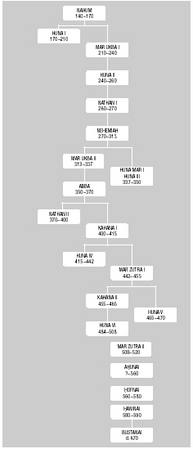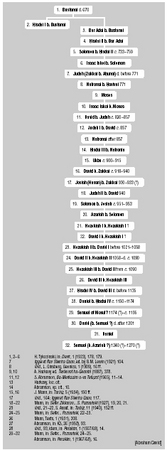Exilarch
EXILARCH (Aram. רֵישׁ גָּלוּתָא, resh galuta), lay head of the Jewish community in Babylon. (See Chart: Exilarchs of Parthian and Sasanid Periods and Chart: Babylonian Exilarchs.)
Until the Arab Conquest
The government of Babylonian Jewry for the first 12 centuries C.E. lay in the hands of the exilarch. Rabbinic traditions incorporated in the *Seder Olam Zuta, trace the origin of the institution to the last years of the exile of Jehoiachin, on the basis of II Kings 25:27. Further data were derived from I Chronicles 3:17ff. Whether such an institution actually existed before Parthian times is not known, and certainty is impossible. Sources on Jewish life in first-century Parthian Babylonia, however, leave little ground to suppose there was an exilarch then. Josephus' account of the Jewish "state" of *Anilaeus and Asinaeus suggests, to the contrary, that no state-sanctioned Jewish government functioned at that time. Whatever the earlier situation, Neusner has put forward the conjecture that the Parthian government under Vologases I (d. 79 C.E.) probably established a feudal regime to govern Jewry as part of its
 List of exilarchs of the Parthian and Sasanid periods (based on F. Lazarus; see bibl.).
List of exilarchs of the Parthian and Sasanid periods (based on F. Lazarus; see bibl.).
reorganization of the Arsacid administration (see *Babylonia). Jews played an important part in first-century Middle Eastern politics, not only in Palestine, but also in *Armenia, *Adiabene, Charax Spasinu, and Babylonia itself. It was important to organize a loyal administration for Jewry, both for the stability of the empire, and for the purposes of foreign affairs. The Jews, living on both sides of the contested frontier between Rome and Parthia, could prove useful to either party able to enlist their support. Furthermore, the destruction of Jerusalem and, with it, the Temple administration which had formerly issued religious instruction to the Diaspora, necessitated Parthian consideration. The Romans, supporting the new rabbinical authority in Jabneh (see *Johanan b. Zakkai), exerted substantially more control than before.
The Parthians, perhaps earlier contented to allow local Jewry to receive instruction from Jerusalem, certainly took advantage of the change in Palestinian politics and the anti-Roman turn in world Jewish opinion, to establish local control of Jewry under close supervision. The result was highly beneficial. In the next century, Jews were the most loyal supporters of the Parthian cause against *Trajan, Septimius *Severus, and Alexander *Severus. In Palestine, circles of Jewish messianists were prepared to cooperate with the Parthians against Rome.
The first clear evidence of the existence of the exilarch comes in the middle of the second century C.E. Some Jewish authority certainly existed about 145 C.E. when *Hananiah the nephew of Joshua b. Hananiah intercalated the calendar in Babylonia (Eccles. R. 7, 8, no. 4, 7:26, for his exile to Babylonia; Ber. 63a; TJ, Sanh. 1:2, 19a; TJ, Ned. 6:13, 40a, for the intercalation). The accounts of the intercalation contain the name of a local official, given variously as Ahijah and Neḥunyon. At about the same time, moreover, Rabban *Simeon b. Gamaliel II rebuked R. Nathan, of Babylonia, for his part in a conspiracy against the former's rule, saying "Granted that the sash of office (kamara) of your father has indeed helped you to become av bet din, shall we therefore make you also nasi?" (Hor. 13b). Since the kamara, mentioned in various Iranian inscriptions, was one of the significations of office in Iran, it stands to reason that R. Nathan was the son of the Jewish ruler of Babylonia. The first talmudic mention of the title of reshgaluta, however, occurs with reference to Huna the exilarch (TJ, Ket. 12:3, 35a; TJ, Kil. 9:3, 32b; Gen. R. 33:3). *Judah ha-Nasi stated that if Huna were to come to Palestine he would give precedence to him, for Huna was descended from the male line of the Davidic household, while the patriarch, from the female line. Ḥiyya and his nephew *Rav may have been related to the exilarch, for both Babylonians claimed Davidic ancestry. Ḥiyya came from the same town as the exilarch, and called his nephew Rav bar Paḥti. The title paḥat was used in the Parthian documents from Nisa for satrap, and if Rav was son of a Jewish paḥat, then his father must have held high rank within the Parthian feudal structure. Other Jewish authorities, earlier in the same period, were reported by Palestinian rabbinic messengers to have Parthian names, wear Parthian dress, enjoy the perquisites of a retinue, and execute capital punishment, and yet to be knowledgeable in the law (Git. 14a–b; TJ, Kid. 3:4, 64a; TJ, Git. 1:5, 43c–d). So it is reasonable to suppose that a Jewish government did exist through the last century and a half of Parthian rule in Babylonia.
 List of Babylonian exilarchs during the Middle Ages.
List of Babylonian exilarchs during the Middle Ages.
The advent of the Sassanids, in 226 C.E., necessitated the provision of a new political foundation for Jewish self-government. At first, the Jewish administrators continued as before, hoping to hoodwink the Sassanids and forcibly to keep the Jews in line. R. Shila, for example, administered lashes to a man who had intercourse with a gentile woman; the man informed against him, whereupon a government agent (parastak) investigated the case. Shila persuaded the agent that he was loyal, and then murdered the informant (Ber. 58a). But in a similar situation, R. *Kahana had to flee to Palestine (BK 117a), for, Rav told him, "Until now the Greeks [Parthians] were here, who did not punish bloodshed, but now the Persians are here, and they will certainly cry, 'Rebellion, rebellion!'" For their part, the Sassanids under Ardashir I (226–42), who were closely associated with the cult of Ormuzd and Ānahīta, thought they could forcibly convert the various peoples of Babylonia and Mesopotamia to their religion. So for the first two decades of Sassanian rule, no modus vivendi could be reached. *Shapur I (242–272) chose a different, more tolerant policy, encouraging Mani to preach a syncretistic religion of Buddha, Zoroaster, and Jesus (but not Moses!) to appeal to the several major groups of the empire, and seeking to conciliate the Jewish community as well. The Jewish government was given a legitimate role in administering Jewish affairs, when it promised to abide by state law in matters of concern to the state, specifically rules of land tenure and payment of taxes. The agreement of *Samuel and Shapur I, summarized by Samuel's teaching that "the law of the government is law," was closely adhered to by the Jewish regime, which enjoyed a secure position, with few, brief interruptions, for the next four centuries. It is not known what role, if any, the exilarch played in the negotiations preceding this agreement. If there was one Jewish government in Babylonia, as seems plausible, then Samuel must have been acting in its behalf. But rabbinic traditions, which are the only ones to survive, do not mention the participation of the contemporary exilarch, Mar *Ukba I, in the matter.
Rabbinic opinion on the third-century exilarchate was divided. In the early part of the century, it is clear that the leading rabbis were subordinate to the exilarch. Rav was forced by him to administer market prices, which Rav held was not a proper function of the agoranomos, or market supervisor. Samuel deferred to the exilarch Mar Ukba. It was, after all, the exilarch who had earlier employed rabbinically trained functionaries in the courts and bureaus of Babylonia in late Arsacid times. He had done so probably to circumvent the local Jewish strongmen, typified by Anilaeus and Asinaeus in the first century, and the Parthianized Jewish nobility referred to above, in the second century. The rabbis appealed to the people on the basis of their knowledge of Mosaic revelation, which, they held, was unique to their schools, and they moreover affirmed the exilarch's claim to Davidic origin. At the outset, therefore, the rabbinate and the exilarchate were closely allied against the centripetal forces of feudal autonomy represented by local Jewish upper-class landholders. By the last third of the
When, under Pērōz (459–84), Jews and Christians were persecuted, the exilarch Huna V was executed, according to the letter of R. Sherira, in the year 470. The office of exilarch remained vacant for some time. The virtual chaos of the reigns before Khusro I (531–79) combined with the anti-Jewish activities of the Mazdakites supported by the throne in the time of Kavadh (488–531), and the economic depression of the period, produced a lapse in orderly government for Jewry as well. For a time (c. 510–20) the exilarch Mar *Zutra II threw off fealty to the throne, probably provoked by Kavadh's support of Mazdak. From Khusro onward, the situation was restored to its former favorable condition.
BIBLIOGRAPHY:
UNTIL THE ARAB CONQUEST: F. Lazarus, in: Bruell, Jahrbuecher, 10 (1890), 1–181; A.D. Goode, in: JQR, 31 (1940/41), 149–69; J. Liver, Toledot Beit David (1959), 37–46; M. Beer, in: Zion, 28 (1963), 3–33; idem, in: PAAJR, 35 (1967), 43–74; Neusner, Babylonia, 1 (1965), 50–58, 97–112; 2 (1966), 92–125; 3 (1968), 41–94; 4 (1968), 73–124; J. Gafni, in: Niv ha-Midrashiyyah (1968/69), 221–3; M. Beer, Rashut ha-Golah be-Bavel bi-Ymei ha-Mishnah ve-ha-Talmud (1970). FROM THE ARAB CONQUEST ON: Neubauer, Chronicles, 1 (1887), 63–67; 2 (1895), 78–87; Ibn Daud, Tradition, index; H. Tykocinski, in: Devir, 1 (1923), 145–79; J. Mann, in: Sefer Zikkaron… S. Poznański (1927), 18–32; Mann, Texts, index; idem, in: Tarbiz, 5 (1934), 148–61; I. Goldziher, in: Jeschurun (ed. by J. Kobak), 8 (1871), 76–78; idem, in: REJ, 8 (1884), 121–5; S. Pines, ibid., 100 (1936), 71–73; F. Lazarus, in: MGWJ, 78 (1934), 279–88; W. Fischel, ibid., 79 (1935), 302–22; idem, in: Sefer Magnes (1938), 181–7; A.D. Goode, in: JQR, 31 (1940/41), 149–69; S. Assaf, Geonim, 24–41; S.D. Goitein, in: Sefer ha-Yovel… M.M. Kaplan (1953), 51–53; idem, in: Bo'i Teiman, ed. by Y. Ratzaby (1967), 15–25; Abramson, Merkazim, 9–24; G. Vajda, in: Bulletin de l'Institut de Recherche et d'Histoire des Textes, 15 (1967/68), 137–50.
Sources: Encyclopaedia Judaica. © 2007 The Gale Group. All Rights Reserved.


